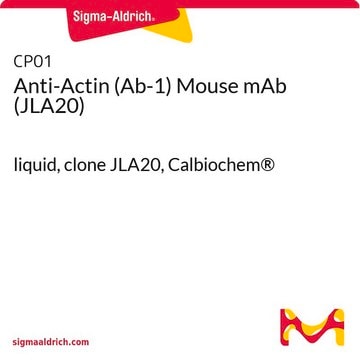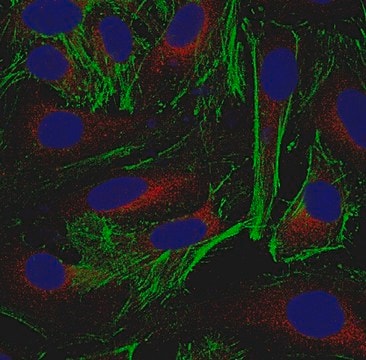MABT219
Anti-Actin Antibody, clone JLA20
clone JLA20, from mouse
Sinónimos:
Actin, alpha skeletal muscle, Alpha-actin-1
Seleccione un Tamaño
$484.00
Seleccione un Tamaño
About This Item
$484.00
Productos recomendados
origen biológico
mouse
Nivel de calidad
forma del anticuerpo
purified immunoglobulin
tipo de anticuerpo
primary antibodies
clon
JLA20, monoclonal
reactividad de especies
human
reactividad de especies (predicha por homología)
chicken (immunogen homology)
técnicas
immunofluorescence: suitable
western blot: suitable
isotipo
IgMκ
Nº de acceso NCBI
Nº de acceso UniProt
Condiciones de envío
wet ice
modificación del objetivo postraduccional
unmodified
Información sobre el gen
human ... ACTA1(58)
Descripción general
Aplicación
Western Blot Analysis: A representative lot was used by an independent laboratory in Me4405 melanoma cell lysate. (Thomas, W.D., et al. (2000). Journal of Immunology. 165:5612–5620.)
Calidad
Western Blot Analysis: A 1:1,000 dilution of this antibody detected Actin on 10 µg of SK-BR3 cell lysate.
Descripción de destino
Ligadura / enlace
Forma física
Nota de análisis
SK-BR3 cell lysate
Otras notas
¿No encuentra el producto adecuado?
Pruebe nuestro Herramienta de selección de productos.
Opcional
Código de clase de almacenamiento
10 - Combustible liquids
Clase de riesgo para el agua (WGK)
WGK 2
Punto de inflamabilidad (°F)
Not applicable
Punto de inflamabilidad (°C)
Not applicable
Certificados de análisis (COA)
Busque Certificados de análisis (COA) introduciendo el número de lote del producto. Los números de lote se encuentran en la etiqueta del producto después de las palabras «Lot» o «Batch»
¿Ya tiene este producto?
Encuentre la documentación para los productos que ha comprado recientemente en la Biblioteca de documentos.
Active Filters
Nuestro equipo de científicos tiene experiencia en todas las áreas de investigación: Ciencias de la vida, Ciencia de los materiales, Síntesis química, Cromatografía, Analítica y muchas otras.
Póngase en contacto con el Servicio técnico







